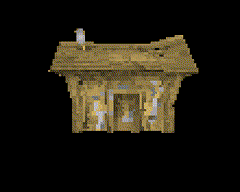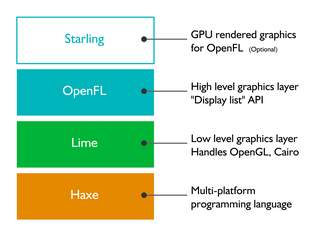Related Research Articles

Microsoft DirectX is a collection of application programming interfaces (APIs) for handling tasks related to multimedia, especially game programming and video, on Microsoft platforms. Originally, the names of these APIs all began with "Direct", such as Direct3D, DirectDraw, DirectMusic, DirectPlay, DirectSound, and so forth. The name DirectX was coined as a shorthand term for all of these APIs and soon became the name of the collection. When Microsoft later set out to develop a gaming console, the X was used as the basis of the name Xbox to indicate that the console was based on DirectX technology. The X initial has been carried forward in the naming of APIs designed for the Xbox such as XInput and the Cross-platform Audio Creation Tool (XACT), while the DirectX pattern has been continued for Windows APIs such as Direct2D and DirectWrite.
Adobe Flash is a discontinued multimedia software platform used for production of animations, rich internet applications, desktop applications, mobile apps, mobile games, and embedded web browser video players.

OpenGL is a cross-language, cross-platform application programming interface (API) for rendering 2D and 3D vector graphics. The API is typically used to interact with a graphics processing unit (GPU), to achieve hardware-accelerated rendering.
Direct3D is a graphics application programming interface (API) for Microsoft Windows. Part of DirectX, Direct3D is used to render three-dimensional graphics in applications where performance is important, such as games. Direct3D uses hardware acceleration if it is available on the graphics card, allowing for hardware acceleration of the entire 3D rendering pipeline or even only partial acceleration. Direct3D exposes the advanced graphics capabilities of 3D graphics hardware, including Z-buffering, W-buffering, stencil buffering, spatial anti-aliasing, alpha blending, color blending, mipmapping, texture blending, clipping, culling, atmospheric effects, perspective-correct texture mapping, programmable HLSL shaders and effects. Integration with other DirectX technologies enables Direct3D to deliver such features as video mapping, hardware 3D rendering in 2D overlay planes, and even sprites, providing the use of 2D and 3D graphics in interactive media ties.
Direct3D and OpenGL are both application programming interfaces (APIs) that can be used in applications to render 2D and 3D computer graphics. As of 2005, graphics processing units (GPUs) almost always implement one version of both of these APIs. Examples include: DirectX 9 and OpenGL 2 circa 2004; DirectX 10 and OpenGL 3 circa 2008; and most recently, DirectX 11 and OpenGL 4 circa 2011. GPUs that support more recent versions of the standards are backwards compatible with applications that use the older standards; for example, one can run older DirectX 9 games on a more recent DirectX 11-certified GPU.

In computer graphics, a shader is a computer program that calculates the appropriate levels of light, darkness, and color during the rendering of a 3D scene—a process known as shading. Shaders have evolved to perform a variety of specialized functions in computer graphics special effects and video post-processing, as well as general-purpose computing on graphics processing units.

OpenGL for Embedded Systems is a subset of the OpenGL computer graphics rendering application programming interface (API) for rendering 2D and 3D computer graphics such as those used by video games, typically hardware-accelerated using a graphics processing unit (GPU). It is designed for embedded systems like smartphones, tablet computers, video game consoles and PDAs. OpenGL ES is the "most widely deployed 3D graphics API in history".
A shading language is a graphics programming language adapted to programming shader effects. Shading languages usually consist of special data types like "vector", "matrix", "color" and "normal".
Adobe Flash Player is computer software for viewing multimedia content, executing rich Internet applications, and streaming audio and video content created on the Adobe Flash platform. It can run from a web browser as a browser plug-in or independently on supported devices. Originally created by FutureWave under the name FutureSplash Player, it was renamed to Macromedia Flash Player after Macromedia acquired FutureWave in 1996. It was then developed and distributed by Adobe as Flash Player after Adobe acquired Macromedia in 2005. It is currently developed and distributed by Zhongcheng for users in China, and by Harman International for enterprise users outside of China, in collaboration with Adobe.

Software rendering is the process of generating an image from a model by means of computer software. In the context of computer graphics rendering, software rendering refers to a rendering process that is not dependent upon graphics hardware ASICs, such as a graphics card. The rendering takes place entirely in the CPU. Rendering everything with the (general-purpose) CPU has the main advantage that it is not restricted to the (limited) capabilities of graphics hardware, but the disadvantage is that more transistors are needed to obtain the same speed.

Perl OpenGL (POGL) is a portable, compiled wrapper library that allows OpenGL to be used in the Perl programming language.
Web3D, also called 3D Web, is a group of technologies to display and navigate websites using 3D computer graphics.

WebGL is a JavaScript API for rendering interactive 2D and 3D graphics within any compatible web browser without the use of plug-ins. WebGL is fully integrated with other web standards, allowing GPU-accelerated usage of physics, image processing, and effects in the HTML canvas. WebGL elements can be mixed with other HTML elements and composited with other parts of the page or page background.

Away3D is an open-source platform for developing interactive 3D graphics for video games and applications, in Adobe Flash or HTML5. The platform consists of a 3D world editor, a 3D graphics engine, a 3D physics engine and a compressed 3D model file format (AWD).
Three.js is a cross-browser JavaScript library and application programming interface (API) used to create and display animated 3D computer graphics in a web browser using WebGL. The source code is hosted in a repository on GitHub.

Flare3D is a framework for developing interactive three-dimensional (3D) graphics within Adobe Flash Player, Adobe Substance and Adobe AIR, written in ActionScript 3. Flare3D includes a 3D object editor and a 3D graphics engine for rendering 3D graphics. Flare3D runs on current web browsers utilizing the Adobe Flash Player, and uses Stage3D for GPU-accelerated rendering. Flare3D has not been under active development since late 2014.
Papervision3D is an open-source, 3D graphics engine for rendering 3D content within Adobe Flash Player and Adobe AIR.
Adobe Scout is a visual profiler for Adobe Flash content running on desktop or mobile platforms, and works together with Adobe Flash Player and Adobe AIR. Scout enables in-depth profiling of ActionScript 3 code execution, 2D graphics and text rendering, and 3D graphics rendered via the Stage3D application programming interface (API).

OpenFL is a free and open-source software framework and platform for the creation of multi-platform applications and video games. OpenFL applications can be written in Haxe, JavaScript, or TypeScript, and may be published as standalone applications for several targets including iOS, Android, HTML5, Windows, macOS, Linux, WebAssembly, Flash, AIR, PlayStation 4, PlayStation 3, PlayStation Vita, Xbox One, Wii U, TiVo, Raspberry Pi, and Node.js.

Cg and High-Level Shader Language (HLSL) are two names given to a high-level shading language developed by Nvidia and Microsoft for programming shaders. Cg/HLSL is based on the C programming language and although they share the same core syntax, some features of C were modified and new data types were added to make Cg/HLSL more suitable for programming graphics processing units.
References
- 1 2 3 4 5 Joseph Labrecque (2011). What's New in Flash Player 11. O'Reilly Media, Inc. p. 17. ISBN 978-1-4493-1110-0.
- 1 2 Adobe Premium Features for Flash Player, Flash Player Dev Center, Adobe
- 1 2 Stage3D unsupported chipsets, drivers, Flash Player 11, AIR 3, Adobe Help
- ↑ Matt Fisher (2013). HTML5 for Flash Developers. Packt Publishing Ltd. § Stage3D versus WebGL, p. 91. ISBN 978-1-84969-333-2.
- 1 2 3 "Stage3D vs WebGL Performance — Airtight Interactive". Airtightinteractive.com. 2011-10-28. Retrieved 2014-08-04.
- ↑ Joseph Labrecque (2011). What's New in Adobe AIR 3. O'Reilly Media, Inc. pp. 17–26. ISBN 978-1-4493-1108-7.
- ↑ Remi Arnaud (2011). "3D in a Web Browser". In Eric Lengyel (ed.). Game Engine Gems 2. CRC Press. pp. 207–212. ISBN 978-1-56881-437-7.
- 1 2 Christer Kaitila (2011). Adobe Flash 11 Stage3D (Molehill) Game Programming Beginner's Guide. Packt Publishing Ltd. ISBN 978-1-84969-169-7.
- ↑ "What is AGAL | Adobe Developer Connection". Adobe.com. 2011-10-10. Retrieved 2014-08-04.
- ↑ Wagner James Au (2012). Game Design Secrets. John Wiley & Sons. p. 130. ISBN 978-1-118-46391-8.
- ↑ "Adobe Flash 11 adopts Unreal Engine 3 for better browser games | The Verge". theverge.com. 7 October 2011. Retrieved 2014-08-04.
- ↑ "Tools Spotlight: CopperCube 4.0". MCV. evelop-online.net. 2014-05-28. Retrieved 2014-09-22.
- ↑ Keith Gladstien (2013). Flash Game Development In a Social, Mobile and 3D World. Cengage Learning. pp. 383–421. ISBN 978-1-4354-6021-8.
- 1 2 Thibault Imbert (2012). Introducing Starling. O'Reilly Media, Inc. ISBN 978-1-4493-2089-8.
- ↑ Rex van der Spuy (2012). Foundation Game Design with ActionScript 3.0. Apress. p. 641. ISBN 978-1-4302-3993-2.
- ↑ Thibault Imbert (December 4th, 2012) Introducing Game Developer Tools (Gaming SDK, Adobe Scout, FlasCC)
- ↑ "Adobe Gaming SDK". creative.adobe.com. Retrieved 2014-08-04.
- 1 2 3 4 5 Adobe Flash Roadmap, Adobe
- 1 2 And Then Premium Features Arrived Archived 2015-02-05 at the Wayback Machine , ASV Guy Blog
- ↑ Update: Premium Features for Flash Player, Adobe AIR and FP Blog
- ↑ Imbert, Thibault. "Introducing Flash Player 11.4/AIR 3.4 beta!". ByteArray.
- ↑ "Stage3D". scratch.mit.edu. Retrieved 2014-08-05.
- ↑ Adobe Flash Player 11.8 - Bug 3591185: Pixel Bender shader performance drastically degraded in FP11.8. Closed as "NeverFix" Archived 2014-04-22 at the Wayback Machine
- ↑ "Stage3D compressed textures – Introducing the ATF SDK - ByteArray.org". bytearray.org. Retrieved 2014-08-04.
- 1 2 3 4 5 Getting started with Adobe Scout, Adobe Developer Connection
- 1 2 3 4 5 What is AGAL, Adobe Developer Connection
- ↑ Mipmapping for smoother textures in Stage3D, Adobe Developer Connection
- ↑ Session : Flash to the Max! High Performance 3D Graphics in Silent Hunter Online, GDC Europe 2013
- 1 2 FLSL, Flare3D Wiki
- ↑ HLAG is currently in alpha, HLAG Tool Website
- ↑ Crytek, Silent Hunter Online talks late additions to GDC Europe 2013, Gamasutra, "C++ console rendering engine into Adobe Flash using Actionscript/Stage3D and using AGAL for graphical effects such as ocean rendering"